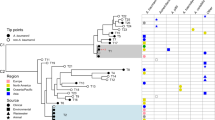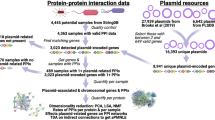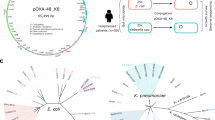Abstract
The ability of bacterial plasmids to adapt to novel hosts and thereby shift their host range is key to their long-term persistence in bacterial communities. Promiscuous plasmids of the incompatibility group P (IncP)-1 can colonize a wide range of hosts, but it is not known if and how they can contract, shift or further expand their host range. To understand the evolutionary mechanisms of host range shifts of IncP-1 plasmids, an IncP-1β mini-replicon was experimentally evolved in four hosts in which it was initially unstable. After 1000 generations in serial batch cultures under antibiotic selection for plasmid maintenance (kanamycin resistance), the stability of the mini-plasmid dramatically improved in all coevolved hosts. However, only plasmids evolved in Shewanella oneidensis showed improved stability in the ancestor, indicating that adaptive mutations had occurred in the plasmid itself. Complete genome sequence analysis of nine independently evolved plasmids showed seven unique plasmid genotypes that had various kinds of single mutations at one locus, namely, the N-terminal region of the replication initiation protein TrfA. Such parallel evolution indicates that this region was under strong selection. In five of the seven evolved plasmids, these trfA mutations resulted in a significantly higher plasmid copy number. Evolved plasmids were found to be stable in four other naive hosts, but could no longer replicate in Pseudomonas aeruginosa. This study shows that plasmids can specialize to a novel host through trade-offs between improved stability in the new host and the ability to replicate in a previously permissive host.
Similar content being viewed by others
Log in or create a free account to read this content
Gain free access to this article, as well as selected content from this journal and more on nature.com
or
References
Agresti A . (2002). Categorical Data Analysis, 2 edn. John Wiley and Sons: Hoboken, NJ.
Ausubel FM, Brent R, Kingston RE, Moore DD, Seidman JG, Smith JA et al. (1988). Current Protocols in Molecular Biology. Wiley: New York, USA.
Bergstrom CT, Lipsitch M, Levin BR . (2000). Natural selection, infectious transfer and the existence conditions for bacterial plasmids. Genetics 155: 1505–1519.
Blasina A, Kittell BL, Toukdarian AE, Helinski DR . (1996). Copy-up mutants of the plasmid RK2 replication initiation protein are defective in coupling RK2 replication origins. Proc Natl Acad Sci USA 93: 3559–3564.
Bouma JE, Lenski RE . (1988). Evolution of a bacteria/plasmid association. Nature 335: 351–352.
Caspi R, Pacek M, Consiglieri G, Helinski DR, Toukdarian A, Konieczny I . (2001). A broad host range replicon with different requirements for replication initiation in three bacterial species. EMBO J 20: 3262–3271.
Chen J, Kadlubar FF, Chen JZ . (2007). DNA supercoiling suppresses real-time PCR: a new approach to the quantification of mitochondrial DNA damage and repair. Nucleic Acids Res 35: 1377–1388.
Cleveland WS, Grosse E, Shyu WM . (1992). Local regression models. In: JM Chambers & TJ Hastie (eds). Statistical Models. Wadsworth Brooks/Cole: Boca Raton, Florida.
Crill WD, Wichman HA, Bull JJ . (2000). Evolutionary reversals during viral adaptation to alternating hosts. Genetics 154: 27–37.
Dahlberg C, Chao L . (2003). Amelioration of the cost of conjugative plasmid carriage in Escherichia coli K12. Genetics 165: 1641–1649.
De Gelder L, Ponciano JM, Joyce P, Top EM . (2007). Stability of a promiscuous plasmid in different hosts: no guarantee for a long-term relationship. Microbiology 153: 452–463.
De Gelder L, Williams J, Ponciano J, Sota M, Top EM . (2008). Adaptive plasmid evolution results in host-range expansion of a broad-host-range plasmid. Genetics 178: 2179–2190.
Diaz E, Munthali M, de Lorenzo V, Timmis KN . (1994). Universal barrier to lateral spread of specific genes among microorganisms. Mol Microbiol 13: 855–861.
Dionisio F, Conceicao IC, Marques AC, Fernandes L, Gordo I . (2005). The evolution of a conjugative plasmid and its ability to increase bacterial fitness. Biol Lett 1: 250–252.
Dosztanyi Z, Csizmok V, Tompa P, Simon I . (2005). IUPred: web server for the prediction of intrinsically unstructured regions of proteins based on estimated energy content. Bioinformatics 21: 3433–3434.
Duffy S, Turner PE, Burch CL . (2006). Pleiotropic costs of niche expansion in the RNA bacteriophage φ6. Genetics 172: 751–757.
Dunnett CW . (1964). New tables for multiple comparisons with a control. Biometrics 20: 482–491.
Durland RH, Helinski DR . (1987). The sequence encoding the 43-kilodalton TrfA protein is required for efficient replication or maintenance of minimal RK2 replicons in Pseudomonas aeruginosa. Plasmid 18: 164–169.
Durland RH, Toukdarian A, Fang F, Helinski DR . (1990). Mutations in the trfA replication gene of the broad-host-range plasmid RK2 result in elevated plasmid copy numbers. J Bacteriol 172: 3859–3867.
Fang FC, Helinski DR . (1991). Broad-host-range properties of plasmid RK2: importance of overlapping genes encoding the plasmid replication initiation protein TrfA. J Bacteriol 173: 5861–5868.
Frost LS, Leplae R, Summers AO, Toussaint A . (2005). Mobile genetic elements: the agents of open source evolution. Nat Rev Microbiol 3: 722–732.
Fuxreiter M, Simon I, Friedrich P, Tompa P . (2004). Preformed structural elements feature in partner recognition by intrinsically unstructured proteins. J Mol Biol 338: 1015–1026.
Guiney DG . (1982). Host range of conjugation and replication functions of Escherichia coli sex plasmid F lac: comparison with the broad host range plasmid RK2. J Mol Biol 162: 699–703.
Guiney DG . (1984). Promiscuous transfer of drug resistance in gram-negative bacteria. J Infect Dis 149: 320–329.
Haines AS, Akhtar P, Stephens ER, Jones K, Thomas CM, Perkins CD et al. (2006). Plasmids from freshwater environments capable of IncQ retrotransfer are diverse and include pQKH54, a new IncP-1 subgroup archetype. Microbiology 152: 2689–2701.
Heuer H, Fox RE, Top EM . (2007). Frequent conjugative transfer accelerates adaptation of a broad-host-range plasmid to an unfavorable Pseudomonas putida host. FEMS Microbiol Ecol 59: 738–748.
Jiang Y, Pacek M, Helinski DR, Konieczny I, Toukdarian A . (2003). A multifunctional plasmid-encoded replication initiation protein both recruits and positions an active helicase at the replication origin. Proc Natl Acad Sci USA 100: 8692–8697.
Kamachi K, Sota M, Tamai Y, Nagata N, Konda T, Inoue T et al. (2006). Plasmid pBP136 from Bordetella pertussis represents an ancestral form of IncP-1β plasmids without accessory mobile elements. Microbiology 152: 3477–3484.
Kneller DG, Cohen FE, Langridge R . (1990). Improvements in protein secondary structure prediction by an enhanced neural network. J Mol Biol 214: 171–182.
Kongsuwan K, Josh P, Picault MJ, Wijffels G, Dalrymple B . (2006). The plasmid RK2 replication initiator protein (TrfA) binds to the sliding clamp β subunit of DNA polymerase III: implication for the toxicity of a peptide derived from the amino-terminal portion of 33-kilodalton TrfA. J Bacteriol 188: 5501–5509.
Konieczny I, Helinski DR . (1997). Helicase delivery and activation by DnaA and TrfA proteins during the initiation of replication of the broad host range plasmid RK2. J Biol Chem 272: 33312–33318.
Lenski RE, Simpson SC, Nguyen TT . (1994). Genetic analysis of a plasmid-encoded, host genotype-specific enhancement of bacterial fitness. J Bacteriol 176: 3140–3147.
Levy SB, Marshall B . (2004). Antibacterial resistance worldwide: causes, challenges and responses. Nat Med 10: S122–S129.
Lin J, Helinski DR . (1992). Analysis of mutations in trfA, the replication initiation gene of the broad-host-range plasmid RK2. J Bacteriol 174: 4110–4119.
Maestro B, Sanz JM, Diaz-Orejas R, Fernandez-Tresguerres E . (2003). Modulation of pPS10 host range by plasmid-encoded RepA initiator protein. J Bacteriol 185: 1367–1375.
Maestro B, Sanz JM, Faelen M, Couturier M, Diaz-Orejas R, Fernandez-Tresguerres E . (2002). Modulation of pPS10 host range by DnaA. Mol Microbiol 46: 223–234.
Martinez B, Tomkins J, Wackett LP, Wing R, Sadowsky MJ . (2001). Complete nucleotide sequence and organization of the atrazine catabolic plasmid pADP-1 from Pseudomonas sp. strain ADP. J Bacteriol 183: 5684–5697.
Modi RI, Adams J . (1991). Coevolution in bacterial-plasmid populations. Evolution 45: 656–667.
Modi RI, Wilke CM, Rosenzweig RF, Adams J . (1991). Plasmid macro-evolution: selection of deletions during adaptation in a nutrient-limited environment. Genetica 84: 195–202.
Oldfield CJ, Cheng Y, Cortese MS, Romero P, Uversky VN, Dunker AK . (2005). Coupled folding and binding with alpha-helix-forming molecular recognition elements. Biochemistry 44: 12454–12470.
Pacek M, Konopa G, Konieczny I . (2001). DnaA box sequences as the site for helicase delivery during plasmid RK2 replication initiation in Escherichia coli. J Biol Chem 276: 23639–23644.
Pansegrau W, Lanka E, Barth PT, Figurski DH, Guiney DG, Haas D et al. (1994). Complete nucleotide sequence of Birmingham IncPα plasmids. Compilation and comparative analysis. J Mol Biol 239: 623–663.
Providenti MA, O’Brien JM, Ewing RJ, Paterson ES, Smith ML . (2006). The copy-number of plasmids and other genetic elements can be determined by SYBR-green-based quantitative real-time PCR. J Microbiol Methods 65: 476–487.
R-development-core-team (2009). R: A language and environment for statistical computing. R Foundation for Statistical Computing: Vienna, Austria, http://www.R-project.org.
Rost B, Yachdav G, Liu J . (2004). The PredictProtein server. Nucleic Acids Res 32: W321–W326.
Schlüter A, Szczepanowski R, Pühler A, Top EM . (2007). Genomics of IncP-1 antibiotic resistance plasmids isolated from wastewater treatment plants provides evidence for a widely accessible drug resistance gene pool. FEMS Microbiol Rev 31: 449–477.
Sen D, Yano H, Suzuki H, Król JE, Rogers L, Brown CJ et al. (2010). Comparative genomics of pAKD4, the prototype IncP-1δ plasmid with a complete backbone. Plasmid 63: 98–107.
Shingler V, Thomas CM . (1984). Analysis of the trfA region of broad-host-range plasmid RK2 by transposon mutagenesis and identification of polypeptide products. J Mol Biol 175: 229–249.
Slater FR, Bailey MJ, Tett AJ, Turner SL . (2008). Progress towards understanding the fate of plasmids in bacterial communities. FEMS Microbiol Ecol 66: 3–13.
Stevenson BS, Schmidt TM . (2004). Life history implications of rRNA gene copy number in Escherichia coli. Appl Environ Microbiol 70: 6670–6677.
Strahilevitz J, Jacoby GA, Hooper DC, Robicsek A . (2009). Plasmid-mediated quinolone resistance: a multifaceted threat. Clin Microbiol Rev 22: 664–689.
Taylor LA, Rose RE . (1988). A correction in the nucleotide sequence of the Tn903 kanamycin resistance determinant in pUC4K. Nucleic Acids Res 16: 358.
Thomas CM, Helinski DR . (1989). Vegetative replication and stable inheritancy of IncP plasmids. In: CM Thomas (ed.). Promiscuous Plasmids of Gram-negative Bacteria. Academic Press: London.
Thomas CM, Nielsen KM . (2005). Mechanisms of, and barriers to, horizontal gene transfer between bacteria. Nat Rev Microbiol 3: 711–721.
Thorsted PB, Macartney DP, Akhtar P, Haines AS, Ali N, Davidson P et al. (1998). Complete sequence of the IncPβ plasmid R751: implications for evolution and organisation of the IncP backbone. J Mol Biol 282: 969–990.
Top EM, Holben WE, Forney LJ . (1995). Characterization of diverse 2,4-dichlorophenoxyacetic acid-degradative plasmids isolated from soil by complementation. Appl Environ Microbiol 61: 1691–1698.
Toukdarian A . (2004). Plasmid strategies for broad-host-range replication in gram-negative bacteria. In: BE Funnel & GJ Phillips (eds). Plasmid Biology. ASM press: Washington, D.C., USA, pp 259–270.
Turner PE, Cooper VS, Lenski RE . (1998). Tradeoff between horizontal and vertical modes of transmission in bacterial plasmids. Evolution 52: 315–329.
Turner PE . (2004). Phenotypic plasticity in bacterial plasmids. Genetics 167: 9–20.
Vedler E, Vahter M, Heinaru A . (2004). The completely sequenced plasmid pEST4011 contains a novel IncP1 backbone and a catabolic transposon harboring tfd genes for 2,4-dichlorophenoxyacetic acid degradation. J Bacteriol 186: 7161–7174.
Wichman HA, Badgett MR, Scott LA, Boulianne CM, Bull JJ . (1999). Different trajectories of parallel evolution during viral adaptation. Science 285: 422–424.
Wood DW, Setubal JC, Kaul R, Monks DE, Kitajima JP, Okura VK et al. (2001). The genome of the natural genetic engineer Agrobacterium tumefaciens C58. Science 294: 2317–2323.
Wood TE, Burke JM, Rieseberg LH . (2005). Parallel genotypic adaptation: when evolution repeats itself. Genetica 123: 157–170.
Woods R, Schneider D, Winkworth CL, Riley MA, Lenski RE . (2006). Tests of parallel molecular evolution in a long-term experiment with Escherichia coli. Proc Natl Acad Sci USA 103: 9107–9112.
Zhong Z, Helinski D, Toukdarian A . (2003). A specific region in the N terminus of a replication initiation protein of plasmid RK2 is required for recruitment of Pseudomonas aeruginosa DnaB helicase to the plasmid origin. J Biol Chem 278: 45305–45310.
Acknowledgements
We thank Dr K Kamachi (National Institute for Infectious Diseases, Japan) for his kind gift of pBP136, and Prof N. Goto (Kyoto Pharm. University, Japan) for providing us strain KG2512. We also thank G. Deckert, L. Rogers, D. Sen, N. Packer, M. Bauer, S. Bassler and S. Sax for technical assistance. This project was supported by NIH Grant number P20 RR16448 from the COBRE program of the National Center for Research Resources (NCRR).
Author information
Authors and Affiliations
Corresponding author
Additional information
Supplementary Information accompanies the paper on The ISME Journal website
Supplementary information
Rights and permissions
About this article
Cite this article
Sota, M., Yano, H., M Hughes, J. et al. Shifts in the host range of a promiscuous plasmid through parallel evolution of its replication initiation protein. ISME J 4, 1568–1580 (2010). https://doi.org/10.1038/ismej.2010.72
Received:
Revised:
Accepted:
Published:
Issue date:
DOI: https://doi.org/10.1038/ismej.2010.72
Keywords
This article is cited by
-
Factors associated with plasmid antibiotic resistance gene carriage revealed using large-scale multivariable analysis
Scientific Reports (2023)
-
Coevolution of host–plasmid pairs facilitates the emergence of novel multidrug resistance
Nature Ecology & Evolution (2020)
-
Chromosome organization by a conserved condensin-ParB system in the actinobacterium Corynebacterium glutamicum
Nature Communications (2020)
-
Phenotypical profile and global transcriptomic profile of Hypervirulent Klebsiella pneumoniae due to carbapenemase-encoding plasmid acquisition
BMC Genomics (2019)
-
Emergence of plasmid stability under non-selective conditions maintains antibiotic resistance
Nature Communications (2019)



